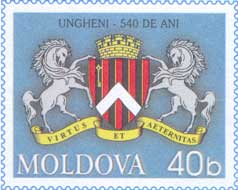Ungheni
| Ungheni | |||
|---|---|---|---|
 |
|||
|
|||
| Location within Moldova | |||
| Coordinates: 47°13′N 27°49′E / 47.217°N 27.817°ECoordinates: 47°13′N 27°49′E / 47.217°N 27.817°E | |||
| Country |
|
||
| County | Ungheni District | ||
| Government | |||
| • Mayor | Alexandru Ambros | ||
| Area | |||
| • Total | 16.4 km2 (6.3 sq mi) | ||
| Population (2014 census) | |||
| • Total | 38,400 | ||
| • Density | 2,300/km2 (6,100/sq mi) | ||
| Time zone | EET (UTC+2) | ||
| • Summer (DST) | EEST (UTC+3) | ||
Ungheni (Romanian pronunciation: [uŋˈɡenʲ]), with a population of 35,157, is the seventh largest town in Moldova and the seat of Ungheni District since 2003.
There is a bridge across the Prut and a border checkpoint to Romania. There is another border town with the same name in Romania (Ungheni, Iași), on the other side of the Prut River.
The first historical mention of Ungheni dates to 20 August 1462. A railway between Ungheni and Chişinău was built in 1875 by Russia in preparation for the Russo-Turkish War (1877–1878). After World War II, the rail route through Ungheni became the main connection between the USSR and Romania.
In 1876 after the spring flooding of the river Prut the railway bridge that linked Moldova and Romania was almost destroyed. Railway Department invited Gustave Eiffel in Bessarabia (Moldova) to redesign and rebuild the bridge. Nowadays it is still a strategic structure under the supervision of the frontier guard.
Ungheni is twinned with:
The first historical mention of Ungheni dates to 20 August 1462
Around 1900
Ungheni river port
Mihai Eminescu statue
...
Wikipedia



